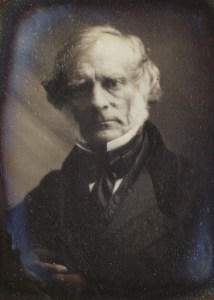The first person to open a photographic portrait studio in Brighton was William Constable (1783-1861), a 58-year-old inventor who had previously worked as a flour miller and high street draper, and had recently been employed as a land and road surveyor. William Constable opened his Photographic Institution on Monday 8th November 1841 at 57 Marine Parade, a large four-storey building situated on Brighton’s eastern seafront, at the corner of Atlingworth Street.

[ABOVE] A daguerreotype portrait of William Constable (1783-1861), Brighton’s first professional photographer. [Photo courtesy of :Philippe Garner].
Constable’s Photographic Institution produced daguerreotype portraits. A daguerreotype was the first practicable method of producing photographic portraits. The daguerreotype process had been invented by Louis Jacques Mande Daguerre (1787-1851), a French theatrical designer and showman, who had perfected the technique of fixing an image on a silver-coated copper plate in the late 1830s. This early form of photograph was given the name daguerreotype by its inventor and the process had been announced to the world in Paris in August 1839.
Richard Beard (1801-1885), a successful coal merchant, and patent speculator, had seen the financial advantages of securing a monopoly in the production of daguerreotype portraits in England. On 23rd March 1841, Richard Beard had opened England’s first photographic portrait studio at the Royal Polytechnic Institution, 309 Regent Street, London. In June 1841, Beard concluded his negotiations with Miles Berry, Louis Daguerre’s patent agent in England, and purchased the patent rights to the daguerreotype process.
By the end of July 1841, Richard Beard had become the sole patentee of the daguerreotype process in England and Wales and had a virtual monopoly in the production of photographic portraits using Daguerre’s method. Until the patent rights expired on 14th August 1853, any person who wanted to legally carry out the art of daguerreotype portrait photography on a commercial basis had to apply to Richard Beard, to either purchase ‘the right of patent’ in a prescribed geographical area or to purchase a licence to work the process in a particular town or city. Reportedly, William Constable had paid £1,000 to Richard Beard for a licence to take daguerreotype portraits in the town of Brighton.
Holding an exclusive licence from Richard Beard, William Constable had a virtual monopoly in the production of photographic portraits in Brighton between November 1841 and 1851. In the Census of 1851, the only other photographer recorded in Brighton was nineteen-year-old Thomas B. Leffen, who was presumably an assistant to William Constable.
Constable had been fortunate to secure Royal patronage and his aristocratic and noble clients saw him safely through his first two years of business at Marine Parade. However, Constable was an astute businessman and was prepared to take steps to ensure a steady flow of sitters. Constable feared that the prices he charged his exclusive clientele would deter other potential customers. By the end of 1843, he had reduced his price for a cased portrait from £1.1s (£1.05p) to 12s 6d (62p), hoping “to possess himself of the patronage of the middle classes of the community.”
At least on one occasion, a daguerreotype artist felt confident enough to challenge Constable’s monopoly in the production of daguerreotype portraits in the town. In the Summer of 1852, a rival to Constable appeared in the form of a French daguerreotype artist, Joseph Meurant, a “Dealer in Fancy Goods” who originated from Paris. In July 1852, Meurant announced in the Brighton Herald that he had opened a ‘Daguerreotype Room’ at 13 East Street, Brighton, where he offered to take likenesses for as little as 5 shillings. Meurant remained in Brighton for less than nine months before moving on to London. It is possible that Meurant had been threatened with legal action, either from the patent holder Richard Beard or from William Constable himself.
After Beard’s Daguerreotype Patent expired in August 1853, a number of Brighton trades people, who had already shown an interest in the art of photography, set up their own daguerreotype portrait studios. As early as 1852, William Lane (1818 -1889), proprietor of ‘Lane’s Cheap Picture Frame Manufactory’, established a ‘Photographic Depot’ at 3 Market Street, Brighton where he supplied “Daguerreotype Lenses, Camera Apparatus” and “every other requisite used in Photography.” A complete set of apparatus for the daguerreotype process cost 7 guineas at Lanes’ Photographic Depot. In an advertisement which appeared eight days before Beard’s daguerreotype patent was due to expire, William Lane was offering to supply ‘Daguerreotype Apparatus’ to operators and amateurs promising “free instruction in the Photographer’s Art to purchasers of materials”. By November 1853, Lane had set himself up as a photographic artist and was offering to provide “a first-class daguerreotype portrait in handsome French case for two shillings” at his new premises at 213 Western Road, Brighton.
Robert Farmer (1823-1859), who had taken over William Passmore’s chemist’s shop at 59 North Street, Brighton in 1852, transformed part of his new business premises into ‘Daguerreotype Rooms’ – which included “a room designed and built expressly with apparatus of very superior construction for the purpose . . . to ensure a fine portrait“. In newspapers issued in November 1853, Robert Farmer publicized his ‘Daguerreotype Rooms’ and “invited the attention of the Ladies, Gentlemen and Visitors to Brighton to his collection of Photographic Portraits, taken plain or in colours, by competent Artists“. Mr. Farmer offered to take “fine portraits” at moderate prices – “1s 6d in case; or coloured 2s 6d“, considerably lower than those charged by William Constable’s Photographic Institution in Marine Parade.